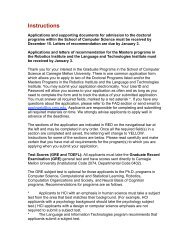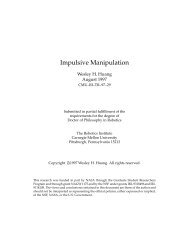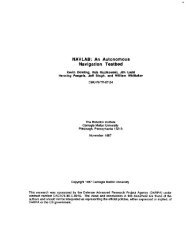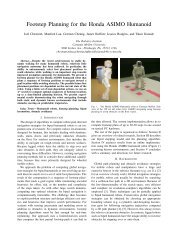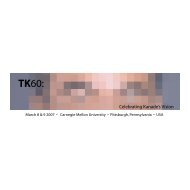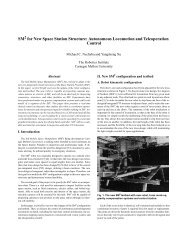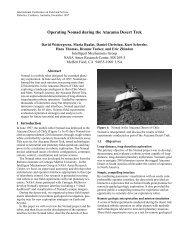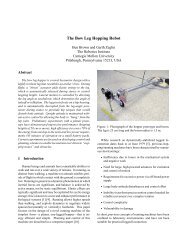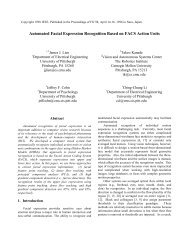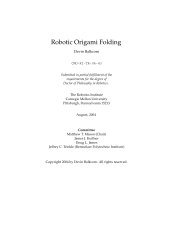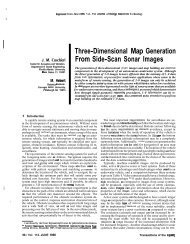A System for Automated Fixture Planning with Modular Fixtures
A System for Automated Fixture Planning with Modular Fixtures
A System for Automated Fixture Planning with Modular Fixtures
You also want an ePaper? Increase the reach of your titles
YUMPU automatically turns print PDFs into web optimized ePapers that Google loves.
3.4.2. Computation of Clamping Force<br />
26<br />
Given clamp locations and an estimation of the direnion and magnitude of cutting <strong>for</strong>ces. our g d k to<br />
estimate the least clamping <strong>for</strong>ce to mainrain the <strong>for</strong>ce and moment equilibrium of the part during<br />
machining.<br />
Here we have proposed a new method to estimate the clamping <strong>for</strong>ce. The problem is fonnulated as an<br />
optimization problem <strong>with</strong> consnaints from static equations and a friction law m avoid any slippage at each<br />
contact. The objective function is a clamping fme at a contact point between a clamp and the part. Since<br />
our pal is to achieve <strong>for</strong>ce and moment equilibrium <strong>with</strong> the least clamping <strong>for</strong>ce, the problem is to<br />
minimize the objective function. This appoach is similar m Keds approach in computing minimal<br />
grasping <strong>for</strong>ce in each finger to maintain <strong>for</strong>ce and moment equilibrium oC the object [Ken 841.<br />
In esrablishing a <strong>for</strong>ce model, only contacts between the part and clamping and Supporring components<br />
are considered because side locating components are primarily used <strong>for</strong> locaring the part and can be ignored<br />
<strong>for</strong> the conservative analysis.<br />
The <strong>for</strong>ce analysis assumes the following:<br />
hand tixturecompoaents are rigid.<br />
Clamping <strong>for</strong>ce is the same at every active(or clamping) contax<br />
Coloumb’s law is wed to model friction at each contact<br />
Friction coefficient is the same at every contact<br />
The friction coefficient between the wortpitoe and a fixture component m y vary drastically depending<br />
on the contact surfaces’ conditions and the marerial The contact sorfaces between the part and fixture<br />
compiments are wet due to a cutting fluid, and a wet friction coefficient should be used 6or the worst case.<br />
Using a Coloumb fiiction model, the constraint equatmn <strong>for</strong> friction <strong>for</strong>ce at the ith active contact is given<br />
as foflows Em 841:<br />
Where Air Aiy are the X and Y component of frkrion <strong>for</strong>ce at the ith conract. p is the fiction coefficient,<br />
and Ni is the clamping <strong>for</strong>ce a! the ith active contact point Quaiion (3.7) describes a cone that resiricts the<br />
direction of the vector summation of two friction <strong>for</strong>ce components. The djreetion oC <strong>for</strong>ce at the contact<br />
should remain <strong>with</strong>in the cone. and-tbe magnitude of friction <strong>for</strong>ce at a contact is limited by a circle whose<br />
radius is pi; (see Figure 3-9).<br />
Since the friction constraints fmm Coloumb’s law are expressed as inequality equations. the optimization<br />
can be done by a l i i propmning (LP) method as long as constraint equations are linear. For example,<br />
the simplex method can be used when the optimization problem is farmdated <strong>with</strong> linear equasims Faha<br />
821. ’Ihe standard <strong>for</strong>mat <strong>for</strong> the simplex memod is given in the previous section. Since the constmint<br />
equation at each contact from Coulomb’s friction law is non-lioear, it is li- by a set of multiple<br />
planes. For example, an invd pyramid <strong>with</strong>in the friction cone can be used to approximate the cone.




